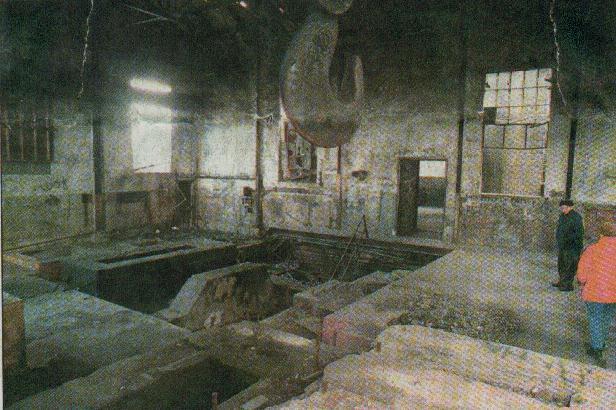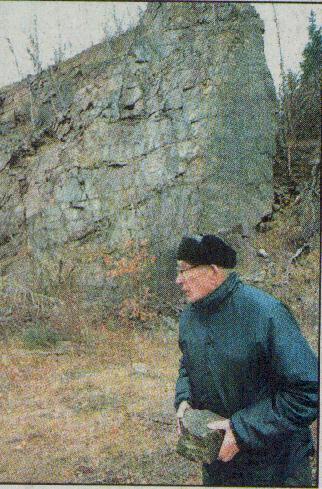
This is the Power House in Lyon Mountain, as it looks today.
Tony Shusda remembers his first day of work in 1936 at the Lyon Mountain mines. He was 21.

"If you had boys in your family and your
father got killed or something, or if they were old enough to work and
lived in that house, the boys worked," he recalled. "If you didn't,
you were out." He also remembers his last day of work at the mines
in 1967, hoping he could make history "I wanted to be the last one to
punch out, but wasn't," he laughed. Second to last would have to do.
Few could match Shusda's intricate knowledge of the iron mining industry,
an industry that spanned the mid 1800s to 1971 when the last of the great
area mines closed in Moriah. And the impact of mining forever changed the
North Country. Shusda, one of many whose job was to dig in rock deep in
the bowels of the Earth, hoist it up and push it through the mill, talks
about mining as if it happened yesterday. "We worked five days a week;
during the war, seven."
There was the Power House with a boiler
room and five compressors (all eventually wound up equipment at ski
areas); the machine-shop fire when the water froze in the 25-below temperatures,
before it could douse the blaze. He remembers the pond that doubled as
swimming hole and a source used to cool the compressors, and he remembers
the day Archie Hart died in that swimming hole. He also recalls, still
with a feeling of sadness, a fateful day in 1940. "My father was killed
in the mine," he says shaking his hand at one of several gaping holes
in the Lyon Mountain landscape. "He went to blast a couple boulders
that were caught, and he got pinned. The guys he was working with just
took off and left him there. He suffocated. It was dangerous," Shusda
said matter-of-factly but "it was a job"
Dr. John Moravek, coordinator of the Geography
Department at Plattsburgh State said the abundance of iron ore was the
reason mining became the lifeblood of dozens of local communities for more
than 100 years. Iron ore was, and still is, concentrated in only few regions,
including the Adirondack-Lake Champlain region. Thousands of tons of iron
ore came from the belly of Adirondack mines to go through crushers, concentrating
plants and furnaces, headed for distant factories to be made into nails,
rolled iron, stoves, machinery, tools railroad track and steel beams that
built a nation. Transportation, mainly by railroad, was critical to every
mining community. Towns with accompanying stores, schools, barbershops
and bars -- grew, developed and revolved around the mines.
Tahawus (Native American for "cloud splitter"),
at the head waters of the Hudson River 40 miles west of Lake Champlain
was once a growing village in the shadow of mining operations.Some impurity
had been found in the Adirondack (later Tahawus) iron that made it unusable
in the 1850s. That by-product was titanium.With obstacles that included
a financial panic and inaccessibility, isolation, difficult transportation
and severity of climate, titanium couldn't be mined, and Adirondac became
a ghost town. In 1941, the National Lead co. (which eventually acquired
Repubic Steel), realizing the country's need for the strategic war mineral
in World War II, began mining titanium. Then, because of the needs of expansion
in 1963, the entire village of Tahawus was moved -- lock, stock and barrel
-- to Newcomb, 12 miles away.
Jack "Sparky" Brennan, an electrical engineer
for Republic Steel in Moriah, knows well what mining towns went through
to keep the business going. Republic Steel arrived in the North Country
in the 1930's. The company came in, upgraded and modernized equipment and
made the job safer. Brennan's memories are of decades of hard work in a
"boom town." With almost 100 mines in the Town of Moriah alone, mining
became a very profitable venture. The "21 Pit", just south of Mineville,
was one of the most productive and prosperous. "It followed two veins
of ore 200 to 800 feet apart. Do you know how long it took for them to
connect when you can go eight feet a day?"
Brennan, too, recalls events surrounding
mining with great ease. He remembers that women did not work in the mines
or the plant, only in the office and warehouse. He recalls the tragedy
in 1951 that claimed the lives of three men but increased safety with the
installation of steel beams in the mines. He can also remember his great
uncle Jim Brennan, who was in a brawl. "That man was shot in the stomach,
fell in a shaft, (was) carried out, walked in his house and died",
Brennan said.
But years of mining deeper and deeper into
the ground proved to be the nail in the coffin of the north Country's iron
industry. "The cost of just getting the iron ore to the light of day
became prohibitive", Moravek said. "It simply reached a point where
the mining operations were no longer profitable, and Cleveland (the
home of National Lead) pulled the plug." He said it was a shock
to the townspeople who depended on Republic Steel. "North Country residents
were caught off guard when the announcement came that they were closing
the mines."
The Lyon Mountain mines closed in 1967;
the Moriah mines followed suit in 1971. "There are now many low-cost
alternatives to iron, including recycling. To re-open, (the mining
companies) would have to comply with the extensive rules of the Adirondack
Park Agency and Department of Environmental Conservation." Moravek
said there's plenty of iron ore left in the North Country, "more
than what has ever been removed. Re-opening the mines is not unthinkable,
but very remote. I can't forsee circumstances that would prompt a revival.
It's a matter of supply, demand and profitability." He said the expense
of re-development seems extremely prohibitive, and, besides, there are
so many low-cost alternatives. "Why would anyone come back here?"
North Country mines, long abandoned,
are now home to thousands of bats and other assorted creatures. Echoes
of the past ripple through the accompanying dilapidated buildings. Brennan
is a guest speaker for area organizations and the source of knowledge for
the Iron Center, a former carriage-house-turned-museum near the Town Hall
in Port Henry. Shusda moved to Plattsburgh State, where he worked in security
at the college and then the bookstore. Except for the occasional rmble
of town trucks, a dead silence now prevails at the Lyon Mountain mines.
That's OK as far as Shusda is concerned. There's one word to describe the
best part of his experience working in the mines. "NOTHING".


Sources:
Mining History page;
Plattsburgh Press Republican; Jan. 3, 1999;
article by Louise Spring, Photos by Dave Paczak.
Also see:
Lyon Mountain page 1.
Lyon Mountain page 2.
Lyon Mountain page 3.

